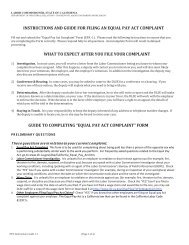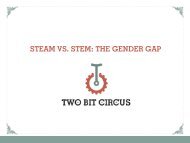EQUITY
2eGXKK2
2eGXKK2
You also want an ePaper? Increase the reach of your titles
YUMPU automatically turns print PDFs into web optimized ePapers that Google loves.
The occupation of ‘automotive body and<br />
related repairers’ is projected to have<br />
almost 50,000 job openings nationally;<br />
median annual earnings in the occupations<br />
are close to $40,000 (Table 4.1). Women<br />
are fewer than 2 percent of the workforce.<br />
Indeed, the real life job titles listed on<br />
O*Net for this occupation include ‘Body<br />
Man’ or ‘Auto Body Man,’ signaling that this<br />
is not a job typically envisaged for women.<br />
Comparing the typical skills and knowledge<br />
attributes of this occupation to those of<br />
'packaging and filling machine operators,' an<br />
occupation that is majority female, shows<br />
considerable similarities but provide much<br />
lower earnings (Figure 4.3).<br />
Creating and maintaining work cultures that respect<br />
workers and protect their opportunities to be trained<br />
and become skilled workers, irrespective of who they<br />
are, will benefit the industry overall, not just women<br />
seeking to enter the industry<br />
Comparing mechanic and service<br />
technician occupations through O*Net<br />
characteristics does not suggest any other<br />
close occupations that already employ a<br />
large number of women. The occupations<br />
require very specific skill sets that need<br />
to be acquired in training and education<br />
programs. Yet they also require many other<br />
skills that are common in occupations that<br />
employ larger numbers of women, including<br />
in the on-ramp occupations already profiled<br />
in this report. These include precision,<br />
monitoring of operations, manual dexterity,<br />
use of software, information retrieval,<br />
working in noisy environments, and wearing<br />
protective clothing. Women and girls are<br />
less likely than men to have been given<br />
the opportunity to work with tools and to<br />
informally learn about engines, and thus<br />
may be less confident than men to apply for<br />
training programs in such fields. Targeted<br />
outreach and pre-training programs can<br />
overcome such barriers and improve the<br />
attractiveness of the industry to women.<br />
Cargo and Freight Agents<br />
A target occupation with more potential<br />
female on-ramp occupations is ‘cargo and<br />
freight agents.’ While the occupation is not<br />
large, it is fast growing and is projected to<br />
have 31,300 job openings between 2014<br />
and 2024. ‘Cargo and freight agents’ have<br />
median annual earnings of $42,729; work<br />
in the occupation requires a high school<br />
diploma and on-the-job experience and<br />
training but no college degree. Three of<br />
ten workers (31 percent) in the occupation<br />
are women. Figure 4.5 shows majorityfemale<br />
occupations that are very similar<br />
to ‘cargo and freight agents’ according to<br />
O*Net criteria. Each of the four potential<br />
majority female on-ramp occupations<br />
have lower median annual earnings and<br />
require the same if not more general level<br />
of education and on-the-job training:<br />
'dispatchers (except police and ambulance)'<br />
and 'customer service representatives,'<br />
both occupations that are very similar, apart<br />
from being majority female (55.7 percent<br />
and 67.8 percent respectively) and having<br />
lower median annual earnings ($37,332 and<br />
$32,436 respectively). The next two closest<br />
occupations —‘human resource assistants<br />
except payroll and timekeeping’, and<br />
‘secretaries and administrative assistants’—<br />
typically require higher levels of education<br />
(post-secondary vocational qualifications)<br />
but also provide lower median annual<br />
earnings ($40,738 and $36,401 respectively)<br />
and are predominantly female (80.9 and<br />
95.4 percent respectively).<br />
30 NARROWING THE WAGE GAP BY IMPROVING WOMEN’S ACCESS TO GOOD MIDDLE-SKILL JOBS




